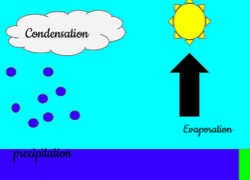This lesson is for : Grade 3:
Summary
Students reviewed the steps in the water cycle that we’ve been studying in class (SOL3.9). Then they were tasked to create an animated model of the water cycle using a Google presentation. First they created a title slide with a background image of a water scene. They changed the font, size, and color of the text to make it stand out against the background. Next they created a blank slide and chose a background color. They used the shapes tool to illustrate water, land, the sun, clouds, and arrows. To make the rain they created small circle shapes, copied and pasted them until they had multiple rain drops, then grouped them together. They also added text labels to each part. After they had all the elements of their image, they started adding animations to each step in the correct order. Finally the students published their slideshows to the web and pasted the links to Google classroom.
See student sample: https://docs.google.com/presentation/d/1LKluAH9nMR5Fpc8PCNl3LtcC6eWTDw86-cvoFWD4yxc/pub?start=false&loop=false&delayms=3000&slide=id.p
TIPC Ratings
Research & Information Fluency
Rating: Not Observed – Explanation: Students did not do research for this project. It was based on information they had already learned in class about the water cycle.
Communication & Collaboration
Rating: Developing – Explanation: Students worked on the animations individually, but they posted their projects online. To rate higher, students could have worked together in groups and even collaborated with an expert meteorologist.
Critical Thinking & Problem Solving
Rating: Developing – Explanation: Students synthesized the information they learned about the water cycle to create an original animated model. To rate higher, students could have selected their own animation tool instead of everyone using Google presentations.
Creativity & Innovation
Rating: Approaching – Explanation: Students created their own unique animations with their own artwork, fonts, and colors. To rate higher, students could have taken risks and gone beyond the assignment in creative new ways. They could have reflected on the creative process with a rubric.




